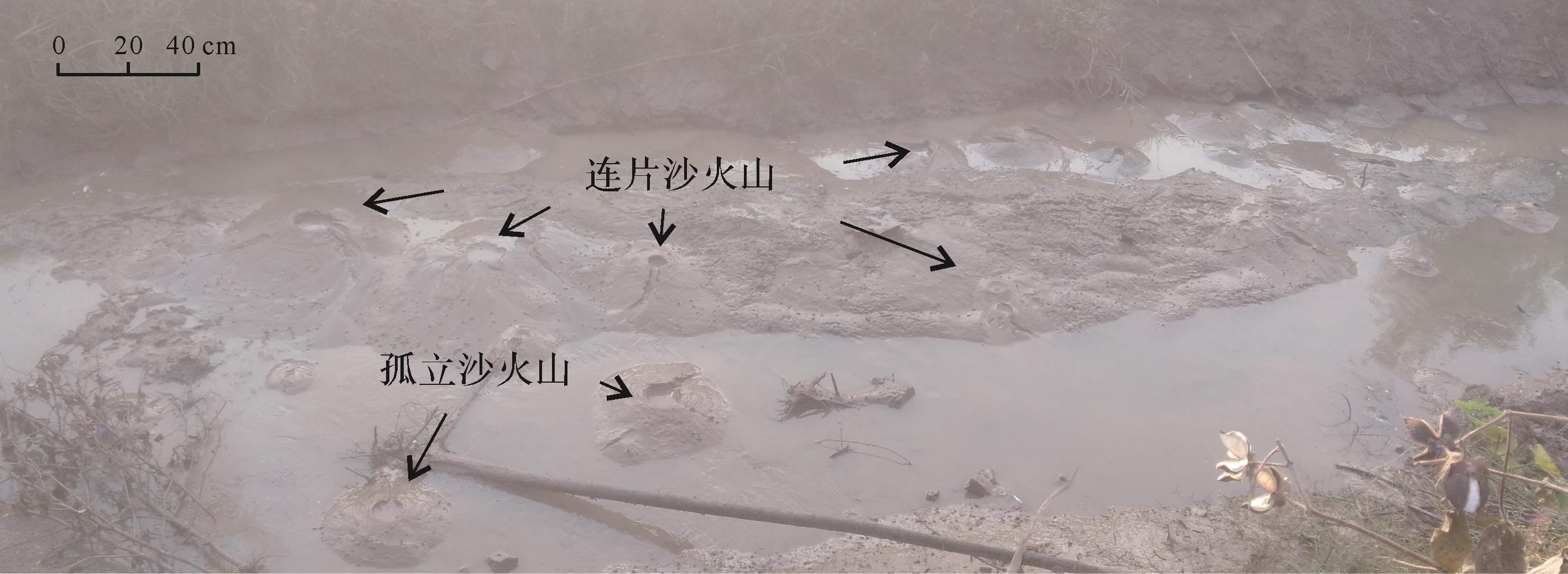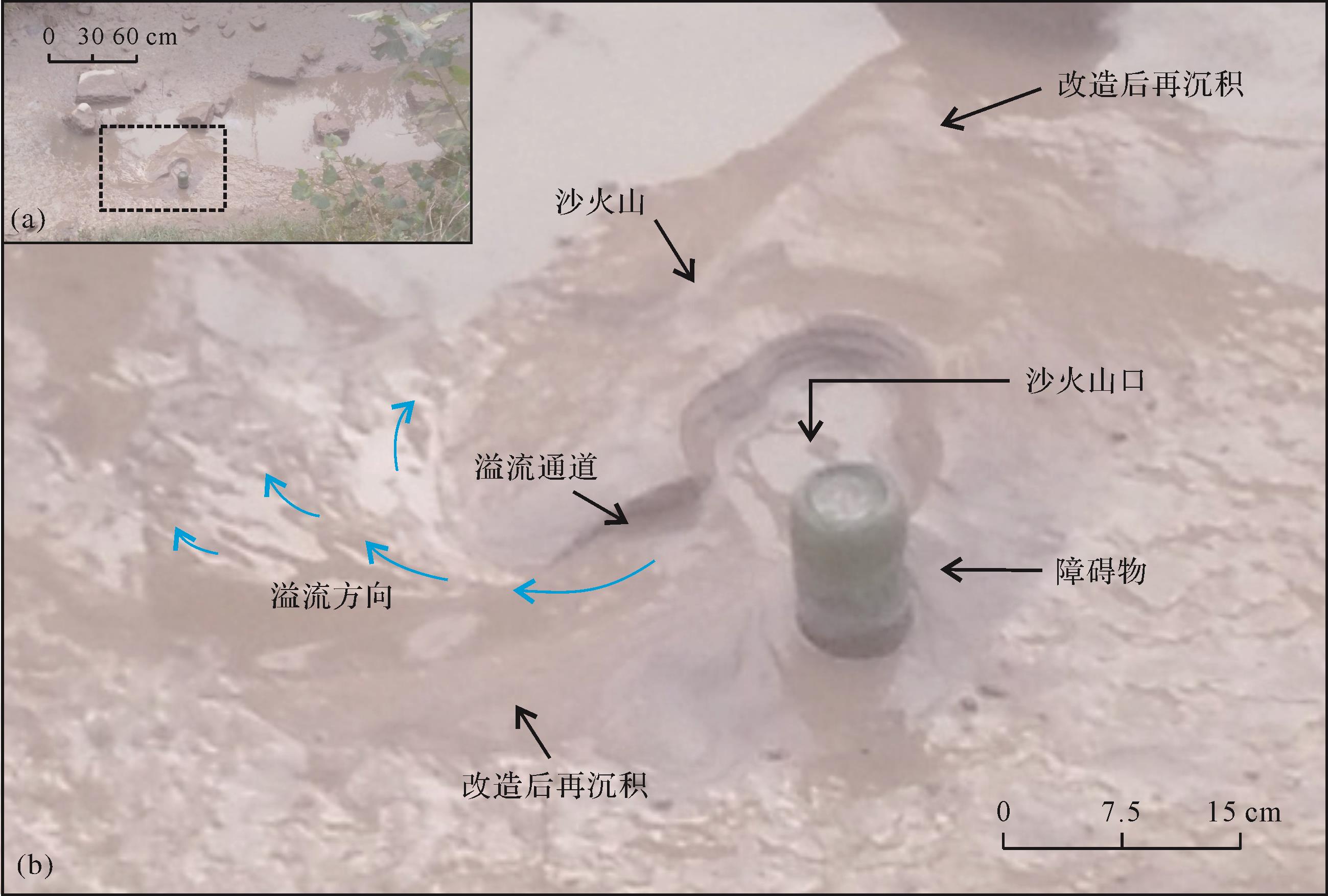HTML
-
沉积后尚未固结的砂体在饱和孔隙流体和外部动力触发机制作用下发生液化、流化,砂体侵入围岩或者喷出地表形成的侵入单元、喷出单元,与液化后的母岩单元共同组成砂岩侵入体系[1]。大量报到的震积岩、软沉积变形层基本对应母岩单元,而砂脉、砂岩墙则对应侵入单元中的液化砂体。地质历史时期,由于喷出单元形成于古地表或古水底,颗粒细小、颗粒之间粘滞力低,在风流、水流的干扰下很难被保存于地层中[2-11],现有文献报道的沙火山大部分是现代地震的产物[12-15]。地震可以为母岩液化提供足够的能量,高震级的地震常伴有砂体液化、侵入和喷出,目前比较公认的砂体液化触发机制为地震作用[2,16-23],大量专家学者认可地震重要作用的同时,提出海啸、陨石、彗星或者小行星撞击、火山喷发、山体滑坡等非地震事件同样可以触发砂体液化[24-39]。能量较强的地质事件,触发形成的砂体液化发育时间短,现代沉积的相关工作多开展于地震等事件发生之后,地质现象也多为构造定型后的产物。而关于砂体液化形成过程和发育机制的相关研究,绝大多数与物理模拟实验有关[40-46]。本次报道的沙火山形成于现代河道之中,规模不同的沙火山组成及火山口涌出物质具有明显差异,笔者认为不同特征的沙火山处于不同的演化阶段,对其特征及形成机制进行研究可以为软沉积变形研究提供参考。
-
本次报到的沙火山发育在山东省菏泽市一小型河道内,河水水位降低,河床底部出现大量丘状隆起(图1),组成该类构造的沉积物粒度较细,以粉砂和泥为主,堆积物形态与火山构造极为相似(图2),为典型的沙火山构造。
从单个沙火山看,其结构一般由圆锥状的沙丘、沙火山口、液化砂岩(或者水)溢流通道组成。沙火山规模大小不一,较小火山锥底面直径8 cm左右、高度小于10 cm,而规模较大的沙火山底面直径大于70 cm,高度大于40 cm。溢流通道一般对应规模偏大的沙火山,绝大多数溢流通道位于火山锥靠近河道中心一侧(图1)。沙火山口规模及涌出水流不同,小型沙火山对应的火山口一般偏小,溢流出的水体浑浊,而多数火山口较大的沙火山溢流物质为清澈水流。
空间分布极不均衡,可以是孤立的火山锥,也可以由多个沙火山连片形成长条状的隆起带,隆起带长轴一般与河道延伸方向一致,局部存在与河道近垂直排列的连片沙火山(图3),本次发现最大的隆起带长轴大于6 m,宽度1 m左右,高度大于0.4 m,隆起带上具有特征明显的沙火山口17个(图1)。
根据规模及组成特征可以将河床沙火山划分为2种类型:有溢流通道型沙火山、无溢流通道型沙火山。其中,有溢流通道型沙火山一般规模偏大,直径一般大于30 cm,高度一般大于20 cm,火山口涌出物为清澈水流,因组成沙火山碎屑颗粒小、清澈水流改造,致使沙火山口有明显的增大迹象,该类沙火山口直径可达10 cm以上;与之相对比的是,无溢流通道型沙火山整体规模偏小,火山口涌出物质为浑浊水流,沙火山口直径绝大多数小于5 cm。对于不同类型的沙火山成因,在后续章节中结合形成的环境及动力进行详细分析。
-
产生本次砂体液化现象的河道具有特殊的背景条件,河道清淤,上覆沉积层重力突然降低是造成砂体液化的主要原因。作为农村灌溉为主的河道,河床底部形态十分特殊,河段两端靠近桥头地区河床偏高,中间相对低洼。雨季,河水上涨,可以漫过下游隆起端,防止洪涝灾害,实现自然向下游泄洪。旱季,河道的中间低洼部位可以储存一定量的河水,方便农田灌溉。该河流因其特殊的河床形态,上层水流速度相对较快,靠近底层的流速缓慢,雨水冲刷两侧堤岸及洪水期上游携带的碎屑矿物,在河床底部常年淤积,河道明显变浅。河床中间低洼段与两侧高部位高差降低,基本丧失了储水功能,当地水利部门对其进行了清淤活动,人为的将河床底部1.5 m左右的沉积物清除。清淤活动之前,液化母岩层地层压力与上覆沉积物重力、上覆岩层沉积物突破压力处于平衡状态,因清淤活动造成上覆岩层变薄,重力、突破压力降低,为液化砂岩的喷出提供了便利,清淤活动打破压力平衡条件是触发砂体液化的主要原因。
季节性的地下水位上升,也可能是触发该河道砂体液化的原因之一。河道清淤活动发生于2019年春季,降水相对较少,地下水位较深,清淤完成之后,并未发现地下水涌出现象。夏季,河道所处的鲁西南地区降水量大,地下水位相应的升高,存在于母岩层内的流体在压力差作用下水平移动,河床部位因上覆岩层的突破压力较小,可以作为超压流体的压力突破点,水体上涌过程中携带粉砂、泥等碎屑物质共同喷出地表,在水底形成沙火山构造。
河道内水位突然降低,地下水位调整也可能造成砂体液化。发现本次砂体液化的季节为2019年秋季,正是该地区秋种之后集中灌溉的阶段,多个抽水泵同时活动造成水位快速下降,河床及其底部的沙火山露出水面。在此过程中,河道对应的水体深度降低较快,河道段下伏的砂体孔隙压力较低,河道周围地层压力较高,在压力差作用下,地下水向河道汇聚,水流携带碎屑物质上涌,形成沙火山。
综合以上几点,河道清淤、地下水位抬升、河道水位快速下降等因素都可以形成压力差,致使砂体孔隙中的水体向河道汇聚,并在薄弱部位喷出地表,形成沙火山构造。
-
在压力差作用下,水流携带颗粒向低势能区域流动,在压力容易突破的薄弱区域形成沙火山。不同规模的沙火山,具有的组成要素和涌出水流特征存在差异(图2),可能处于不同的演化阶段(图4)。
沙火山生长阶段:处于该阶段的沙火山规模较小,无明显的溢流通道,火山口涌出水流浑浊。在砂体母岩单元中流体与河道地表压力差的推动作用下,携带碎屑颗粒的水流突破地表后向四周溢散,水体上涌及溢流过程中速度降低,在火山口周缘堆积。物源从中心向四周减少,造成靠近中心堆积速度较快,开始形成中间高周缘低的构造形态。在此过程中,携带碎屑物质的浑浊水流突破火山口之后,在四散水流、碎屑物质自然安息角的控制下,沙火山规模逐渐增大。由于水流向四周溢散的速度基本相等,水流携带的碎屑物质又可以填平相对低洼的火山口周缘,水流没有优势的流动方向,故而缺少相应的火山溢流通道。
沙火山消亡阶段:进入该演化阶段的沙火山规模相对较大,最明显的特征在于火山口涌出水流变成清水,溢流通道逐步形成。造成水体变清的主要原因可能有两个方面:地层压力和地表压力之间的差值固定,在此压力差下流动的地层水携带砂体的能力变化较小,母岩单元能够被该流速水流携带的碎屑物质逐步减少,故而水体逐渐变清;另外,沙火山生长过程中,地表之上的碎屑物质堆积造成地表高程增大,地表至火山口之间的液柱压力增大,在母岩单元地层压力相对稳定的条件下,地层压力与火山口之间的流体压力差逐渐降低,携带碎屑物质的能力相应的降低,也可能是水流渐渐变清的原因之一。火山口涌出水流变清之后,因缺少母岩碎屑物质补偿,沙火山停止生长。由于河床底部堆积的松散沙火山沉积物本身具备一定的渗透性,水流有向低部位流动的趋势,火山口溢散水流与沙火山孔隙渗流共同叠加后,靠近河道中心一侧(构造低部位)具有更大的重力势能,从而造成该方向水流速度偏大,对沙火山侵蚀强度最大,该部位率先产生溢流通道,从而造成火山溢流通道的方向性,绝大多数沙火山溢流通道的指向河道中心(构造低部位)。当沙火山周缘存在障碍物的条件下,溢流通道方向可能会发生改变,以图3中沙火山为例,水流溢散过程中在障碍物附近发生变化,绕过障碍物的水流与火山口溢流水体叠加,造成障碍物两侧水流速度高于其他方向,溢流通道沿着障碍物一侧形成并逐步加深。溢流通道一旦形成,火山口内的水流无法突破火山顶最高部位,因水流仍有四散溢流的特性,在此状态下开始侵蚀火山口,造成火山口逐步变大,水流在火山口内部形成小型的对流环境,经历翻滚对流之后的水体最后经过溢流通道流出沙火山,流出的水体进一步侵蚀沙火山,造成溢流通道逐步加宽加深,溢流出的水体携带的沉积物在沙火山外围呈扇形展开,受地形因素影响,溢流通道两侧的侵蚀程度存在差异,靠近低部位一侧被侵蚀更严重,高部位一侧可以形成长条状砂体隆起;从沙火山溢流出的水体,与河道水流叠加后,可以进一步改造沙火山,迎着水流一侧沙火山被剥蚀,另一侧受沙火山遮挡,水体流速降低,砂体再次沉积,从而造成了沙火山整体的不对称形态。
总之,沙火山形成之后,演化过程受压力差、周围环境控制,其形态及组成先后具备:规模增大、涌出水流变清、溢流通道产生、沙火山口增大、沙火山改造后再沉积等特征,河道底部存在的不同特征的沙火山可能处于沙火山演化的不同阶段。
-
本次报道的沙火山形成所需的流体压力差小,活动过程中相应的动力弱,保存了相对完整的演化过程,其形成虽受人为活动影响,地质历史时期盆地的特殊构造部位仍可能满足形成条件,开展相关的工作对含油气盆地沉积的研究具备重要的启示意义,主要表现在:
(1) 可以为震积岩相关构造的形成及演化研究提供参考。地震活动过程中,可以形成喷出地表的沙火山、沙锥,液化砂体向上刺穿地层能量较弱时又可以形成液化砂脉、砂席等构造,横向作用力造成局部的隆起,又可以形成无口型沙火山、砂脊等构造。与河床底部沙火山可以类比的是沙火山、砂锥,不同的是地震活动中形成的沙火山需要更大的能量,足够造成流体快速流动携带液化母岩内的碎屑物质上涌,母岩单元内碎屑物质被高速流体带出地表,地震结束后,地层压力降低,颗粒之间孔隙被压缩,从而造成地表塌陷的火山口;河床底部弱流体压力差下形成的砂岩液化,对母岩单元破坏能力有限,不存在碎屑物质回填现象,故而造成火山口周缘整体偏高的地貌。在规模上,河床沙火山明显大于地震活动中形成的砂锥[23],由于地震活动过程中局部超压流体可以喷出地表,流体可以是液态水,也可以是压缩后的高压气体,而气流携带碎屑的能力偏弱,地表形成的沙火山规模偏小,由此推断部分砂锥可能是高压气体喷出后的产物。
(2) 低压力差形成的沙火山在地质条件下可能更具有普遍性。震积岩中各种构造的形成多发生在强震之后[16-18,22-23],本次发现的低流体压力差下,只要存在上覆盖层的薄弱带,便可能形成沙火山,由此可以推断:河床的下切、地下水位的上升、断层活动后地层压力的调整都可以导致沙火山的形成。与本次河道清淤活动类比,单次断层活动断距1.5 m左右,断层带及派生裂缝带附近便可以满足沙火山形成条件。中国东部中新生代断陷盆地中普遍存在的正断层,断陷期必然存在大量断距能够满足砂体液化压力差的断层,流体流动过程中携带的液化砂体可以充填断层带,这种类型的断层具有较差的封闭性,且封闭性与两盘对接岩性关系不大,从而影响油气勘探过程中断层封闭性评价工作;上盘作为主动盘,派生的低序级断层较多,能够为液化砂体提供足够的通道,而正断层活动后上盘可能位于更深的水体环境之下,从而为沙火山的保存提供有利的沉积环境。断裂带附近的砂体再次调整则可能影响断层两侧的地层对比,进一步影响该部位的层序地层研究以及断层控砂模式认识。
(3) 地层中识别出的部分震积岩可能是断层活动的产物。发育于河床底部的沙火山证实,只要母岩单元内流体压力与地面压力差足够突破薄弱带,便可以诱发砂体液化、沙火山形成。盆地断陷活动过程中,断层活动期常伴有强烈的地震,很难区分砂体液化是地震活动还是断层活动引起的。地质时期,缓慢的差异热沉降、沉积物的差异压实同样可以产生断层,足够提供薄弱带以及诱发地层压力重新分布的地质条件,从而产生低压力差环境下的砂体液化。由此可以看出,地层中发现的液化砂岩脉、沙火山等构造发育时期不一定对应强烈的古地震,应该存在部分低压力差诱发的产物。
(4) 地质条件下,触发砂体液化的条件很容易满足,但沙火山的保存难度比较大,地层中该类型的沙火山可能指示极其低能的水环境。前已述及,上覆沉积物厚度变化1.5 m左右,形成的压力差便足以形成长6 m、宽1 m、高0.4 m的连片沙火山,由此可以看出,触发砂体液化的动力条件比较容易满足。因河床顶面低于地下水位,地下水持续补给河道,造成该处沙火山出露时间十分短暂,人工抽水结束后沙火山被快速淹没于水面之下,整体出露的时间持续不足3个小时。笔者拍摄阶段沙火山周围仍有大量积水,因难以靠近,照片全部为河岸拍摄的俯视图。此时,沙火山未固结,火山口仍处于喷水、喷砂阶段,很难截取剖面,进行相应的内部结构及沉积特征描述。为获取沙火山剖面特征,笔者在该年冬季(2020年1月)河床完全干涸后重返该区域,调查发现秋季产生的沙火山已经完全被夷平,虽未能获取沙火山截面特征,但也证实该类沙火山的保存难度极大。笔者推断,该类型的砂岩液化能量远小于地震,能够喷出地表的沉积物粒度较细,在后期流水的改造下,喷出地表的松散沉积物很容易被破坏,低流速的水或地表的风足以破坏该类沙火山,而砂体上涌的通道保存难度相对较小,从而造成地层中液化砂岩脉普遍多于沙火山[1-11]。一旦在地层中发现该类沙火山,可能指示接近静水状态的水动力环境。
-
(1) 现代河床底部存在不同类型的沙火山,规模较大的沙火山常具有明显的溢流通道、较大的火山口、火山口涌出物质为清水,规模较小的沙火山则火山口较小、无溢流通道、涌出水流浑浊。
(2) 不同特征的沙火山可能处于形成演化的不同阶段:在母岩单元地层与地面压力差作用下,液化后的砂体沿着薄弱带突出地表,火山口水流浑浊,均匀向四周溢散,无明显溢流通道;后期母岩单元内可供流体携带的碎屑物质减少,沙火山规模增大,火山口处与地层之间压力差减小,火山口内流速降低、携砂能力降低、水流变清,沙火山终止生长。沙火山演化过程中先后经历:规模增大、涌出水流变清、溢流通道产生、沙火山口增大、沙火山改造后再沉积等特征。
(3) 只要母岩单元与地面的流体压力差,足够突破地层薄弱带,便可以形成一定规模的沙火山,该类型沙火山可以与震积岩砂体液化构造相对比,且在地质历史时期更容易产生,部分非地震活动伴生的断层可以提供压力差、薄弱带,断层带及伴生裂缝带附近可能发育沙火山,并在弱水动力条件下被保存下来。











 DownLoad:
DownLoad:


